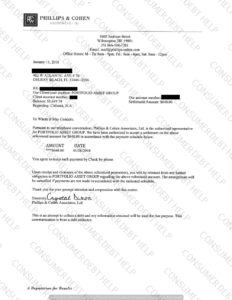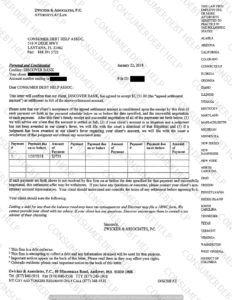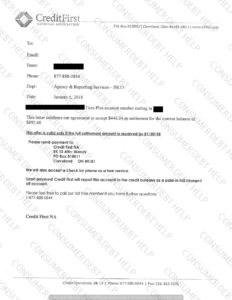Debt Relief Specialist wants to share a settlement letter from Juniper/Barclays Bank. Bal. $1638.33 Offer $574.00 Savings $1064.33

Debt Relief Specialist wants to share a settlement letter from Juniper/Barclays Bank. Bal. $1638.33 Offer $574.00 Savings $1064.33

Since I’m in the process of rebuilding my credit, I thought I’d walk you through some of the steps I’m taking to meet my credit goals.
Please understand that there is no “quick fix” for your credit. Your credit report is created based on your use of money, whether responsibly or irresponsibly. You can, however, put in extra effort by disputing incorrect or out-of-date items on your report, paying off debts, and acquiring one or two new trade lines where you may be lacking. To the rest, I’ll say, “Time heals all wounds.”
My Credit History
Historically, I’ve had dismal credit, but I was able to build it back up to excellent credit with a credit score of over 750. Realistically, I see myself doing that again, because I know it just takes a little time and organization, and I’m not starting from the bottom. My scores range from poor to fair, so I have a bit of a head start.
In the last 5 years or so, I’ve had some derogatory marks added to my reports. I’ve also not had any credit cards, BUT I also have no debts (which is good and bad). This is a big reason my credit is lacking, because this affects my “credit history”, which is an important factor in deciding my credit score, but there are deciding factors. According to FICO, these are the top 5 to consider, in order of importance:
These topics cover many more details that you can find on the Fico Website, but essentially, they will be the most important to you. I would like to add that too many hard inquiries may have a mild negative impact, and public records may have a significant negative effect on your credit score. Public records include liens, judgment, and bankruptcies.
Where to Start When Rebuilding
The first thing you’ll want to do is get your hands on all three of your credit reports and scores, if you don’t already have current copies. You can get all three reports (no scores) through annualcreditreport.com for free, every 12 months, or you can order them directly through the credit bureaus’ websites. Experian offers all three reports with scores for 39.95. Or there are many credit monitoring sites that you can pay a small monthly fee and get updated information monthly on all changes to your report..
DEBTS: If you have unpaid balances, charge-offs, and/or are in collections. This will continue to be a derogatory mark on your credit report. This is absolutely step #1 in improving credit. ALL DEBTS MUST BE PAID, or settled with a $0.00 balance. If they’re not, stop here, and get a plan together today.
Once you have your reports, look over them for inaccuracies. If you find that you may need to dispute inaccuracies or out-dated information, simply dispute the information with the credit bureaus directly. This is the first thing you want to do – clean it up and make sure everything is accurate and updated. The information reported will vary from one credit report to the next, so be thorough.
Next, you’ll want to set some credit goals, and to do that, you need to locate the part of your report that talks about why your score is low. It will usually be titled something like “understanding your score” or “factors affecting your score”. This will let you know what is hurting your credit and what you can do to improve it. Some things will not be able to change. For example, one of mine is “insufficient information on a mortgage account”, which I can’t do anything about since it’s an old (and closed) account. A different bureau has no items to display for me to improve on, which sounds great, but leaves me feeling lost with a mediocre score. What this tells me is there is nothing hurting my score, but I definitely need to still build up my credit responsibly. <— my new goal!
New Revolving Credit Tradelines
Once any disputes are completed to your satisfaction and you have your goals in mind, it’s time to take action. For me, since having no revolving credit was hurting me, I decided to get a secured card through Discover for $500 and only use it at a 10-15% debt-to-credit ratio, meaning I never charge more than $50-$75 on it each month, and pay it off completely and on time. After six months, I can be reevaluated for a larger credit line. After one year, I may qualify for an unsecured card with them based on my payment history. This is a great way to be smart about revolving credit while giving your credit score a lift!
And, I did a lot of research before choosing Discover to help build my credit. Not only are there the above-mentioned features, but I also earn 1% cash back and get to view my FICO score for free through their partnership with TransUnion. It’s a win-win for all involved.
Whatever you do, don’t apply for multiple revolving accounts in a short period of time, as this appears as though you need credit. I only applied for one secured card and will wait 6 months before considering any other revolving accounts. Generally speaking, new accounts may temporarily show negatively on your credit report until around 90 days of on-time payments.
Installment Loans
I was already in the market for a “new” used car for my oldest daughter, and it occurred to me that this may be an opportunity to help build my credit by financing. At first, I was concerned that my credit may not allow the financing, but I soon learned that “fair” scores are considered “good” in a car dealership.
I got a 7.24% interest rate, which isn’t awful, but that’s not really the point. The point is the bank will make a little money off of me, and in return, I will use them to build up my credit. Another win-win!
I didn’t want to be in debt with this purchase or pay massive interest, so I saved up the money in advance and put it in a separate savings account. I put a nice down payment on it (banks like to know you have cash to put down), and was able to finance the rest over 48 months. Of course, I’ll be paying it off in less than a year without penalty, but don’t tell the financing company!
The Bottom Line
I don’t believe credit is essential to life, but it’s definitely essential to qualifying for a mortgage. Most other things you can reasonably save up for, even a used car. Only buy what you can truly afford, even if you finance it, and pay on time, every time.
Everyone makes mistakes, even with credit, or especially with credit, but it can be re over time, and with a little patience and forethought.
Forget making changes to your credit card usage – it’s what you don´t do that can increase your credit score (or at least keep it from going south).
Just as you can´t buy happiness, you can’t buy a high credit score – the only way to get one is to demonstrate financial responsibility. “Creditors don’t care about how many millions you may have in your investment account, it’s how you use your credit.
Steer clear of these 10 things experts say can mangle your score.
(1)Don’t avoid using credit.
If you don´t use credit, you won´t have much of a credit score. “A credit score is an important tool companies use to protect themselves,” Sweet says. The lower the score, the higher the risk, and this can affect whether or not a loan is approved.
(2)Don’t miss payments.
Paying a bill late will hurt your credit, but missing a payment will damage it even more. “If you do so, you can´t make it up,” Sweet says. In other words, making two payments in the next billing cycle will not remove the blemish from your credit history. Whether or not you pay your bills on time determines 33% of your score.
(3)Don’t limit loan types.
Despite what your bank account may think, a car payment and a mortgage may not be enough. Also managing an installment debt, such as a credit card, is a good indicator of credit suaveness. There are five elements to the credit score model and revolving credit, which allows consumers to charge and owe different amounts each month, is one of them. “It´s 10% of the score,” says Gail Cunningham, vice president of public relations for National Foundation for Credit Counseling.
(4)Don’t close unused credit card accounts.
Actually, just use caution, says Sweet. A factor in credit score models is your utilization, which is your debt vs. how much is available. For instance, if you owe $4,800 on a card with a $5,000 limit, you´re using most of your available credit and this “utilization” will have a negative impact on your score. Counting toward 30 percent, your utilization is the second highest factor in your credit score. You should charge no more than 30% of your available credit, recommends Cunningham.
(5)Don’t be a credit tease.
Don´t run up charges all over town or apply for several cards at once while looking for the best rewards program. Recent inquiries means that you have accessed your credit and this can affect your score negatively. “This signals that you´re desperate for credit and don´t have enough cash available for your purchases,” says Cunningham. She adds that if you are shopping for a major purchase, such as a mortgage or car loan, the inquiries will usually roll together into one.
(6)Don’t rob Peter to pay Paul.
Don´t charge anything unless you know how and when you are going to pay it back. One of the benefits of credit is the ability to spread out payments on a big purchase, not to delay paying with hopes that the money will come in – from somewhere. If you need to use a credit card for convenience, use a prepaid card or a secured card that enables you to make payments to your own line of credit.
(7)Don’t get on the call list.
When a debt turns into a collection account, it´s an indication that you got yourself in hot water. Once a collection agency jumps into the arena, it becomes the owner of the debt, which will show on your credit history. Trying to make payments to the original debtor will not make the collection agency or the negative mark on your credit go away.
(8)Don’t forget the little things.
That library fine you didn´t pay or the health club contract you signed but didn´t honor can show up on your credit report. Any debtor has the right to report unpaid bills to the credit bureaus, and many of them exercise that right.
(9)Don’t have a balance of over 30% of your available credit.
Owing money on credit accounts doesn’t necessarily mean you’re a high-risk borrower with a low credit Score. However, when a high percentage of a person’s available credit is been used, this can indicate that a person is overextended, and is more likely to make late or missed payments. Part of the science of scoring is determining how much is too much for a given credit profile. 30% of your FICO Scores take into account this percentage. Note that even if you pay off your credit cards in full each month, your credit report may show a balance on those cards. The total balance on your last statement is generally the amount that will show in your credit report.
(10)Don’t give up.
If you have late payments, missed payments, defaulted loans, and similar credit mess-ups in-between, don´t give up and think that your credit history is ruined. Although offenses like these generally stay on your credit history for seven years, the recovery clock doesn´t start ticking until you have one full month of paying all of your debts on time, says Sweet.
Debt Relief Specialist wants to share a settlement letter from Victoria Secret/Comentiy Bank. Bal. $2093.90 Offer $523.50 Savings $1570.40

Debt Relief Specialist wants to share a settlement letter from Home Design/Synchrony Bank. Bal. $22,427.24 Offer $5607.00 Savings $16,820.24

Debt Relief Specialist wants to share a settlement letter from Home Depot/Citibank. Bal. $1133.43 Offer $300.00 Savings $833.43

Debt Relief Specialist wants to share a settlement letter from Home Depot/Citibank. Bal. $1619.70 Offer $648.00 Savings $971.70

Debt Relief Specialist wants to share a settlement letter from Discover. Bal. $15,780.15 Offer $10,720.00 Savings $5060.15

Debt Relief Specialist wants to share a settlement letter from Discover. Bal. $7498.61 Offer $3751.00 Savings $3747.61

Debt Relief Specialist wants to share a settlement letter from Credit First Bank. Bal. $892.48 Offer $446.24 Savings $446.24

copyright 2024 Consumer Debt Help Association - 516 N. Dixie Highway, Lantana, FL 33462. All Rights Reserved